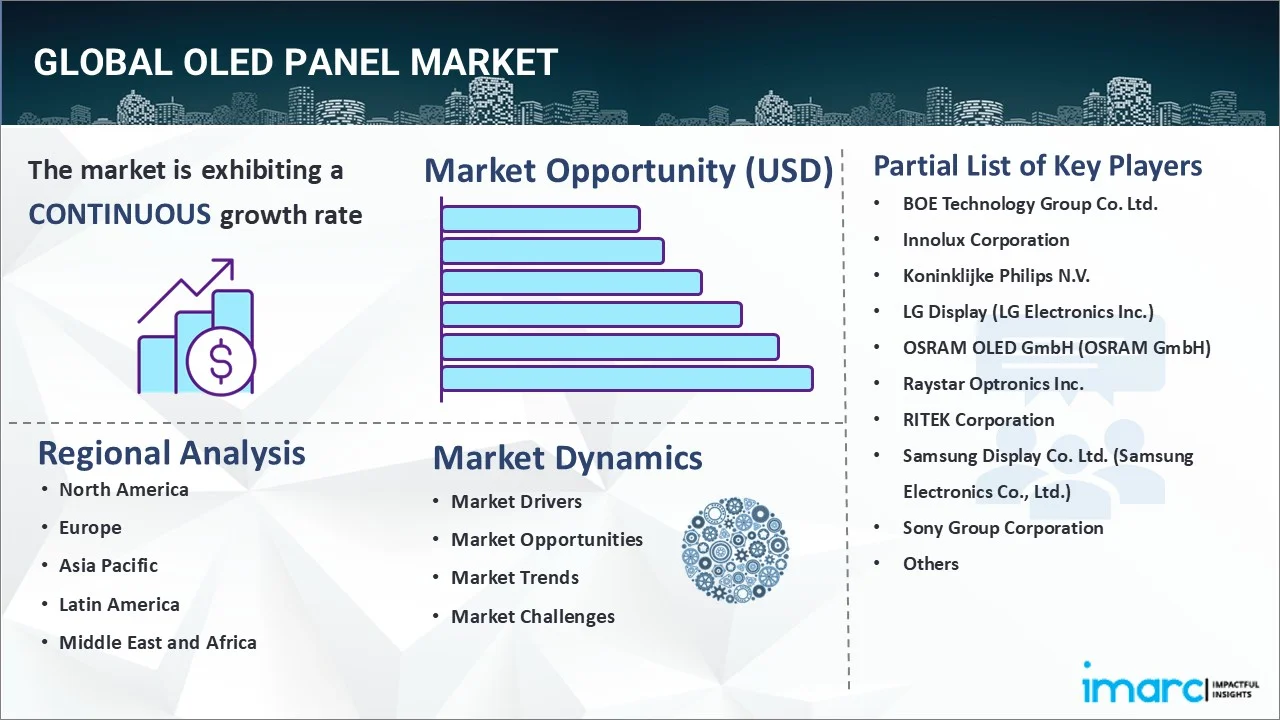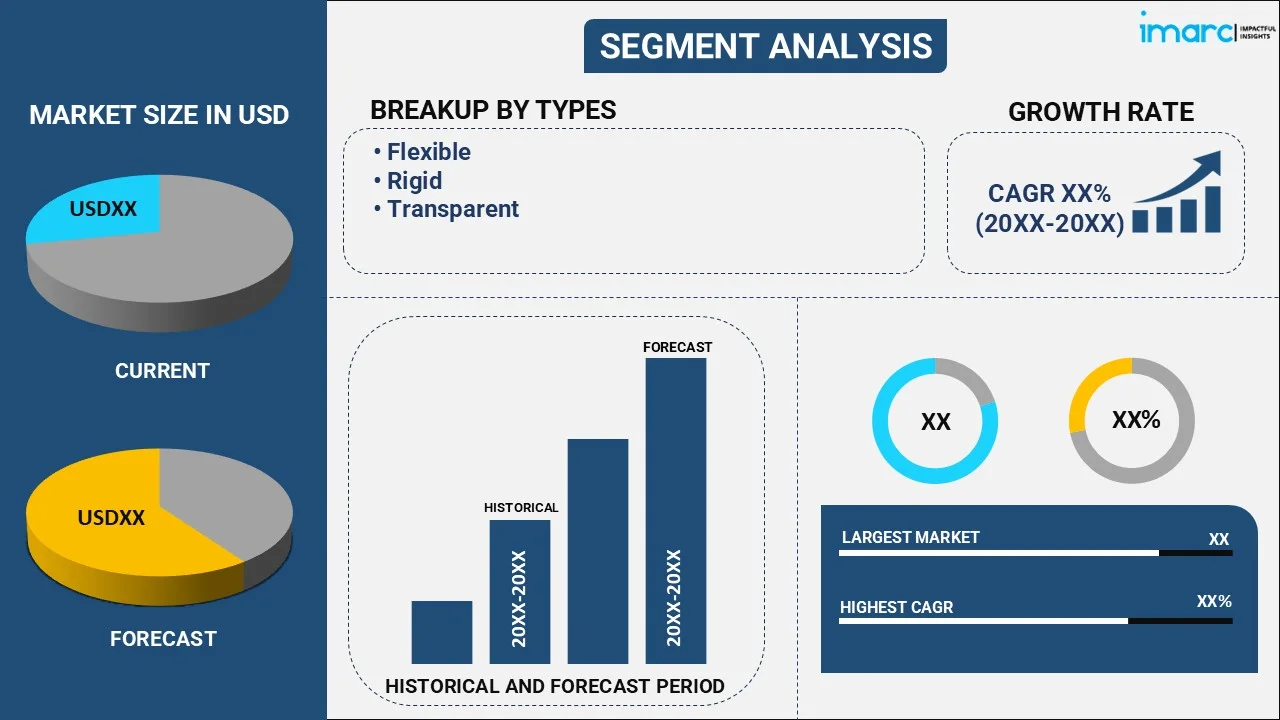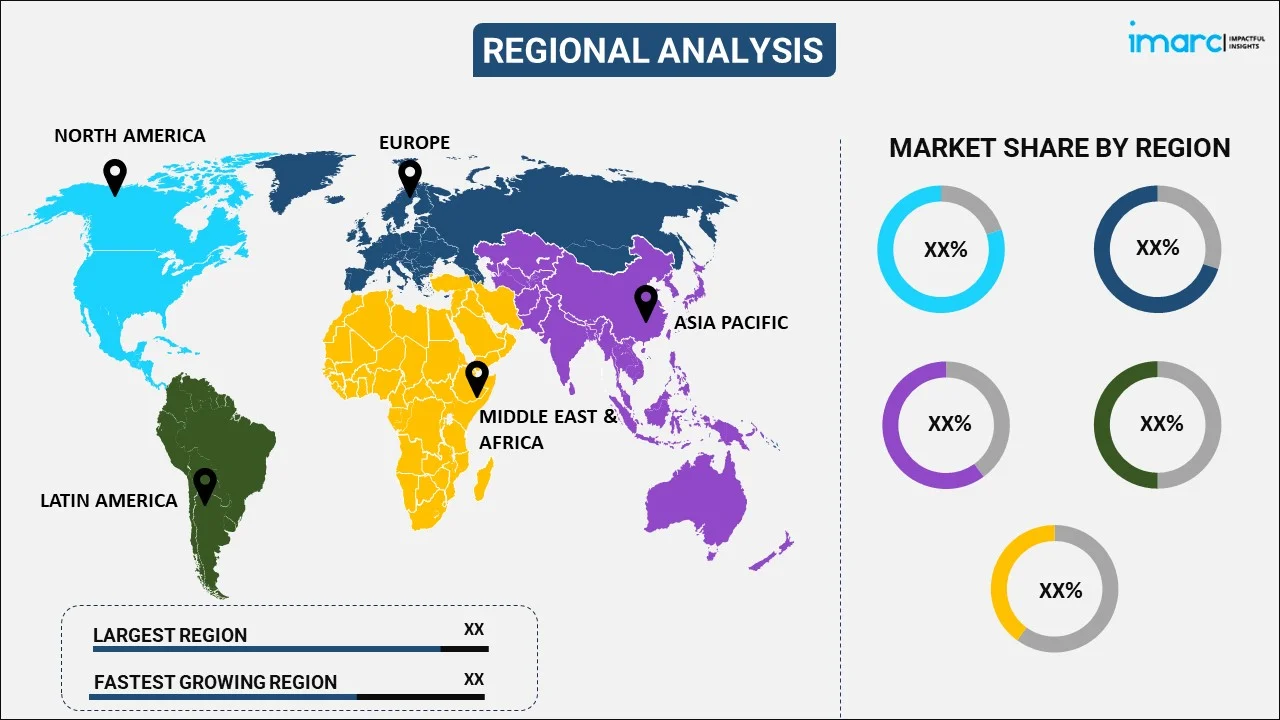
OLED Panel Market Report by Type (Flexible, Rigid, Transparent), Technology (PMOLED Display, AMOLED Display), Size (Small-sized OLED Panel, Medium-sized OLED Panel, Large-sized OLED Panel), End User (Mobile and Tablet, Television, Automotive, Wearable, and Others), and Region 2025-2033
Market Overview:
The global OLED panel market size reached USD 44.2 Billion in 2024. Looking forward, IMARC Group expects the market to reach USD 104.7 Billion by 2033, exhibiting a growth rate (CAGR) of 9.56% during 2025-2033.
|
Report Attribute
|
Key Statistics
|
|---|---|
|
Base Year
|
2024
|
|
Forecast Years
|
2025-2033
|
|
Historical Years
|
2019-2024
|
|
Market Size in 2024
|
USD 44.2 Billion |
|
Market Forecast in 2033
|
USD 104.7 Billion |
| Market Growth Rate 2025-2033 | 9.56% |
Organic light-emitting diode (OLED) panels are manufactured from organic materials that emit light when electricity is applied. They comprise a substrate, backplane, frontplane, and encapsulation layer to avoid oxygen and moisture. They are efficient, thinner, and flexible due to the elimination of backlights and filters compared to liquid-crystal display (LCD) panels. They offer superior viewing angles, fast response time, and small size form factors. As they provide enhanced image quality, bright colors, fast motion, and high contrast, OLED panels are currently widely used on televisions (TVs), smartphones, handheld game consoles, computer monitors, and personal digital assistants (PDAs).

OLED Panel Market Trends:
At present, the growing demand for OLED televisions among the masses due to various advantages with viewing angles and black levels represents one of the key factors driving the market. Besides this, the rising utilization of OLED panels in manufacturing enhanced and foldable smartphones across the globe is contributing to the growth of the market. In addition, key market players are extensively investing in research and development (R&D) activities to install transparent OLED display panels as digital screens. They are also focusing on incorporating active-matrix organic light-emitting diode (AMOLED) panels in their products, which is positively influencing the market. Moreover, the growing demand for consumer electronics, such as computers, laptops, smartphones, tablets, gaming consoles, wearables, digital cameras, and virtual reality (VR) and augmented reality (AR) devices, is offering a positive market outlook. Apart from this, the rising awareness among the masses about the benefits of OLED displays, such as energy-efficient, sunlight-readable, and easier recycling process, compared to liquid-crystal display (LCDs) panels is offering lucrative growth opportunities to industry investors.
Key Market Segmentation:
IMARC Group provides an analysis of the key trends in each sub-segment of the global OLED panel market report, along with forecasts at the global, regional and country level from 2025-2033. Our report has categorized the market based on type, technology, size and end user.
Breakup by Type:

- Flexible
- Rigid
- Transparent
Breakup by Technology:
- PMOLED Display
- AMOLED Display
Breakup by Size:
- Small-sized OLED Panel
- Medium-sized OLED Panel
- Large-sized OLED Panel
Breakup by End User:
- Mobile and Tablet
- Television
- Automotive
- Wearable
- Others
Breakup by Region:

- North America
- United States
- Canada
- Asia-Pacific
- China
- Japan
- India
- South Korea
- Australia
- Indonesia
- Others
- Europe
- Germany
- France
- United Kingdom
- Italy
- Spain
- Russia
- Others
- Latin America
- Brazil
- Mexico
- Others
- Middle East and Africa
Competitive Landscape:
The report has also provided a comprehensive analysis of the competitive landscape in the global OLED panel market. Detailed profiles of all major companies have also been provided. Some of the companies covered include:
- BOE Technology Group Co. Ltd.
- Innolux Corporation
- Koninklijke Philips N.V.
- LG Display (LG Electronics Inc.)
- OSRAM OLED GmbH (OSRAM GmbH)
- Raystar Optronics Inc.
- RITEK Corporation
- Samsung Display Co. Ltd. (Samsung Electronics Co., Ltd.)
- Sony Group Corporation
- Universal Display Corporation
- Visionox Co. Ltd
- Winstar Display Co. Ltd.
- WiseChip Semiconductor Inc.
Kindly note that this only represents a partial list of companies, and the complete list has been provided in the report.
Report Coverage:
| Report Features | Details |
|---|---|
| Base Year of the Analysis | 2024 |
| Historical Period | 2019-2024 |
| Forecast Period | 2025-2033 |
| Units | Billion USD |
| Segment Coverage | Type, Technology, Size, End User, Region |
| Region Covered | Asia Pacific, Europe, North America, Latin America, Middle East and Africa |
| Countries Covered | United States, Canada, Germany, France, United Kingdom, Italy, Spain, Russia, China, Japan, India, South Korea, Australia, Indonesia, Brazil, Mexico |
| Companies Covered | BOE Technology Group Co. Ltd., Innolux Corporation, Koninklijke Philips N.V., LG Display (LG Electronics Inc.), OSRAM OLED GmbH (OSRAM GmbH), Raystar Optronics Inc., RITEK Corporation, Samsung Display Co. Ltd. (Samsung Electronics Co., Ltd.), Sony Group Corporation, Universal Display Corporation, Visionox Co. Ltd, Winstar Display Co. Ltd. and WiseChip Semiconductor Inc. |
| Customization Scope | 10% Free Customization |
| Post-Sale Analyst Support | 10-12 Weeks |
| Delivery Format | PDF and Excel through Email (We can also provide the editable version of the report in PPT/Word format on special request) |
Key Questions Answered in This Report
The global OLED panel market was valued at USD 44.2 Billion in 2024.
We expect the global OLED panel market to exhibit a CAGR of 9.56% during 2025-2033.
The rising demand for OLED panels in televisions, smartphones, handheld game consoles, etc., as they offer enhanced image quality, bright colors, fast motion, and high contrast, is primarily driving the global OLED panel market.
The sudden outbreak of the COVID-19 pandemic had led to the implementation of stringent lockdown regulations across several nations, resulting in the temporary closure of numerous manufacturing units for OLED panels.
Based on the type, the global OLED panel market can be segmented into flexible, rigid, and transparent. Currently, rigid holds the majority of the total market share.
Based on the technology, the global OLED panel market has been divided into PMOLED display and AMOLED display, where PMOLED display currently exhibits a clear dominance in the market.
Based on the size, the global OLED panel market can be categorized into small-sized OLED panel, medium-sized OLED panel, and large-sized OLED panel. Among these, small-sized OLED panel accounts for the majority of the global market share.
On a regional level, the market has been classified into North America, Asia-Pacific, Europe, Latin America, and Middle East and Africa, where Asia-Pacific currently dominates the global market.
Some of the major players in the global OLED panel market include BOE Technology Group Co. Ltd., Innolux Corporation, Koninklijke Philips N.V., LG Display (LG Electronics Inc.), OSRAM OLED GmbH (OSRAM GmbH), Raystar Optronics Inc., RITEK Corporation, Samsung Display Co. Ltd. (Samsung Electronics Co., Ltd.), Sony Group Corporation, Universal Display Corporation, Visionox Co. Ltd, Winstar Display Co. Ltd., and WiseChip Semiconductor Inc.
Need more help?
- Speak to our experienced analysts for insights on the current market scenarios.
- Include additional segments and countries to customize the report as per your requirement.
- Gain an unparalleled competitive advantage in your domain by understanding how to utilize the report and positively impacting your operations and revenue.
- For further assistance, please connect with our analysts.
 Inquire Before Buying
Inquire Before Buying
 Speak to an Analyst
Speak to an Analyst
 Request Brochure
Request Brochure
 Request Customization
Request Customization




.webp)




.webp)












